 Pirates and Privateers Pirates and Privateers
The History of Maritime
Piracy
Cindy Vallar, Editor
& Reviewer
P.O. Box 425,
Keller, TX 76244-0425
    
Books for Adults ~ History: Navy
(United Kingdom)
Number 26 (Royal Navy & US
Navy)
New Series 2
(Royal Marines & US Marines)
New Series 3
(Women & the
Sea)
New Series 4
(Friends & Contemporaries)
New Series 5
(Portrayals of
Nelson)
New Series 8
(Navies in the Georgian Era)
New Series 9
(Naval Intelligence)
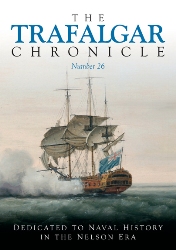
The Trafalgar Chronicle:
Dedicated to Naval History in the Nelson Era
edited by Peter Hore
Seaforth, 2016, ISBN 978-1-4738-9572-0, US $29.95 / UK
£20.00
    
From
two friends who scamper off a warship to hunt
polar bears on an iceberg, to a fifteen-year-old’s
account of the Battle of Northpoint, to HMS Victory’s
appearance at the Battle of Trafalgar, to a seaman
who becomes a marine artist, the twenty-sixth
yearbook of The 1805 Club offers a cornucopia of
topics for every reader. Some, like Horatio
Nelson, HMS Victory, and J. M. W. Turner,
are well-known; others, such as Nicholas Biddle,
Frédéric Rolette, and the Duguay-Trouin,
may only be familiar to a few.
This volume of The
Trafalgar Chronicle contains a new series of
essays whose primary objective is to shed light on
the relationship between the Royal Navy and the
United States Navy. Peter Hore, the editor and a
former naval officer, provides an outstanding
collection of seventeen articles that shed light
on new research about people and events from
before the American Revolution through the
conclusion of the War of 1812 and the Napoleonic
Wars. They are written by experts in their fields
and avid researchers. These men and women include
current and former military personnel, historians,
curators, educators, and archivists.
While there is no
index, the titles of the articles make it easy for
readers to locate information.
- Nicholas Biddle:
America’s Revolutionary War Nelson by Chipp
Reid
- The Earliest
Known ‘Stars and Stripes’ by Peter Hore
- Nelson in
Troubled Waters by Joseph F. Callo
- The Chesapeake--Leopard
Affair, 1807 by Anthony Bruce
- Impressment:
Politics and People by Kathryn Milburn
- A Boy in Battle
by Charles A. Fremantle
- The Rocket’s Red
Glare: Francis Scot Key and the Star-Spangled
Banner by Charles Neimeyer
- Frédéric Rolette:
Un Canadien héros de la guerre de 1812
by Samuel Venière and Caroline Girard
- Pathfinders:
Front-line Hydrographic Data-gathering in the
Wars of American Independence and 1812 by
Michael Barritt
- Charting the
Waters: The Emergence of Modern Marine
Charting and Surveying during the Career of
James Cook in North American Waters, 1758-67
by Victor Suthren
- Captain Archibald
Kennedy, an American in the Royal Navy by
Byrne McLeod
- Admiral Sir Isaac
Coffin: Nelson’s American Pallbearer by Peter
Turner
- What Did HMS Victory
Actually Look Like at the Battle of
Trafalgar? by John Conover
- Thomas
Butterworth: A Biographical Note of a Sailor
Turned Artist by Kathryn Campbell
- Port Mahon under
Admiral Fremantle 1810-11 by Tom D. Fremantle
- Sir Richard
Stachan by Mark West
- Samuel Brokensha,
Master RN by Nigel Hughes
Black-&-white
photographs and drawings accompany all the
articles, some of which also direct readers to
particular illustrations in the center section of
color plates. Notes listing source material or
providing additional information for each article
are collected at the end of the book, as are brief
biographies of the contributors.
The Trafalgar
Chronicle offers a tantalizing look into
forgotten or overlooked subjects. Its contents
will enlighten all readers, and sometimes
entertain them. When the back cover closes, each
will have their own favorites for many different
reasons, myself included. For example,
Rear-Admiral Callo’s article allows me to glimpse
the history behind a novel I recently read.
Charles Freemantle’s offering not only introduces
me to his ancestor, but also allows me to see
Baltimore and its environs in the past through the
eyes of a stranger during a time of war. These are
but two of mine, although all the contributions
taught me things I didn’t know. The next yearbook,
whose emphasis will be on Royal Marines and the US
Marine Corps during the Georgian Ear, sounds
equally intriguing.
Review Copyright ©2017 Cindy Vallar

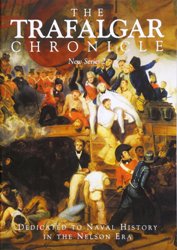
The Trafalgar Chronicle New Series 2
edited by Peter Hore
Seaforth, 2017, ISBN 978-1-4738-9976-6, UK £20.00
/ US $32.95
    
The Royal Marines,
whose history traces back to
1664, and the United States
Marine Corps, first founded in
1775, gains distinction when
the world is at war between
1792 and 1815. Past histories
often have given short shrift
to these sea soldiers, but
here The 1805 Club allows them
to take center stage. The
various essays chosen for
inclusion demonstrate the
vital roles they play and
illustrate why they
participate in “every
important action of fleet,
afloat and ashore during the
Great War.” (5) The
contributors include navy and
marine personnel, academics,
researchers, writers, and
historians.
The book opens with Julian
Thompson’s “The Marines: The
Early Days,” which explores
the origins of the British
Marines, how they become the
Royal Marines, who they are,
and what they do during their
first 151 years. Anthony Bruce
focuses on “The Marines in
Boston, 1774-75,” with
particular emphasis on the
events leading up to and
including the Battle of Bunker
Hill, while Britt Zerbe
examines their participation
in the Battle of Trafalgar and
their marginalized treatment
in the age of sail in “That
Matchless Victory: Trafalgar,
the Royal Marines and Sea
Battle in the Age of Nelson.”
In “Leathernecks: The US
Marine Corps in the Age of the
Barbary Pirates,” Charles
Neimeyer discusses the origins
of their contemporary nickname
and their activities in
America’s war with Tripoli,
which is immortalized in the
“Marines’ Hymn.” Benjamin
Armstrong also looks at this
war, but his focus is on
Commodore Edward Preble and
naval diplomacy in “‘Against
the Common Enemies’: American
Allies and Partners in the
First Barbary War.”
Two other essays discuss the
naval officers who also hold
commissions in the Marines,
even though they never serve
as marines themselves. John D.
Bolt’s “The ‘Blue Colonels’ of
Marines: Sinecure and Shaping
the Royal Marine Identity”
explains this practice and how
Royal Marines view it, as well
as how it affects their
ability to advance through the
ranks. David Clammer focuses
on one particular officer, who
is charged with defending
England’s coastline from a
French invasion in “Captain
Ingram, the Sea Fencibles, the
Signal Stations and the
Defence of Dorset.”
“The Royal Marines Battalions
in the War of 1812” by
Alexander Craig looks at raids
and encounters in the
Chesapeake Bay and Canada,
while Robert K. Sutcliff’s
“The First Royal Marine
Battalion’s Peninsular War
1810-1812” examines their
activities in Portugal and
Spain. Tom Fremantle explores
the thirty-six-year career of
“Captain Philip Gidley King,
Royal Navy, Third Governor of
New South Wales,” an ancestor
who serves on several ships
before being sent to Botany
Bay to establish a base for
the convict colony.
Larrie D. Ferreriro discusses
the French and Spanish navies
in “The Rise and Fall of the
Bourbon Armada, 1744-1805:
From Toulon to Trafalgar,”
while Jann M. Witt explores
“Smuggling and Blockade
Running during the
Anglo-Danish War of 1807-14.”
Another author, Allan Adair,
also writes about his
ancestors. He focuses on two
brothers – one a captain in
the Royal Marines, the other a
fourteen-year-old master’s
mate – who participate in
Trafalgar in “Loyal Au Mort:
The Adairs at the Battle of
Trafalgar.” Sim Comfort, on
the other hand, turns his
attention to a weapon and the
man who wields it in “The
Royal Marine Uniform Sword by
Blake, London, Provenanced to
Captain Richard Welchman,
Royal Marines.”
Two additional entries in this
book provide glimpses into two
men who are veterans of
Trafalgar: “Marine Stephen
Humphries 1786-1865” and
“Captain James Cottell: The
Pictorial Life of a Trafalgar
Veteran.” Humphries’s account
of Trafalgar, his first fight,
his time as a prisoner of the
French, and his participation
in the march on Washington are
from his memoir, one of the
few written by a marine that
has survived to the present
day. In the other offering,
John Rawlinson provides
background to tie together
Cottell’s life with the many
sketches and watercolors that
he makes while at sea.
For me, these last two
offerings are the most
intriguing and absorbing, but
all the essays enlighten
readers and illuminate men who
deserve more recognition but
rarely receive it. Excerpts
from primary documentation are
included in some, while
resources consulted and other
materials are listed in the
endnotes. Recruiting posters,
maps, portraits, paintings,
and tables are among the
illustrations included with
the contributions. A center
section of color plates,
including Geoff Hunt’s
painting of marines aboard a
ship, further enriches the
text. There is also a list of
contributors with short
biographies. As always, the
yearbook shines a spotlight on
tantalizing new naval research
in the 18th and early 19th
centuries, and this edition
with its focus on the marines
makes this a praiseworthy
contribution to any library or
historian fascinated with the
Georgian Navy.
Review Copyright ©2018 Cindy
Vallar

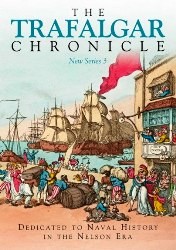
The Trafalgar
Chronicle New Series 3
edited by Peter Hore
Seaforth, 2018, ISBN
978-1-4738-9976-6, UK £20.00 /
US $32.95
Also available in other formats
The Trafalgar
Chronicle explores new
research about the Georgian
navy (also known as Nelson’s
Navy). Since the articles
support a central theme for
each edition, this latest
issue focuses on women and the
sea during this time period.
As Margarette Lincoln points
out in the opening essay,
“Women and the Sea,” this
topic is often overlooked
until 1990 when women in the
Royal Navy are finally
permitted to serve at sea and
Jo Stanley’s Bold in Her
Breeches: Women Pirates
across the Ages is
published in 1995. This latest
volume of The Trafalgar
Chronicle “is an
important step in furthering
our understanding of women’s
myriad connections with the
sea.” (12)
The eighteen remaining
articles cover a wide range of
topics. Peter James Bowman’s
“A Real-life Jane Austen
Heroine and her Naval Hero”
discusses the love story of
Katherine Bisshopp and George
Pechell. “Questing for Cuba
Cornwallis, Nelson’s
Afro-Caribbean Nurse” is Jo
Stanley’s hunt to learn more
about the woman who tends
Horatio Nelson during his
illness in Jamaica in 1780,
and to understand why her
minor role in his life has
“been elevated into almost a
heroine, and been so widely
interpreted on the basis of so
very little evidence.” (28)
Kevin Brown examines
prostitution and the navy in
“Portsmouth Polls and Spithead
Nymphs: Sexual Health in
Nelson’s Navy.”
Using letters and
correspondence, Heather
Noel-Smith and Lorna M.
Campbell explore the lives of
three women – two mothers of
midshipmen and Susan Pellew,
their commander’s wife – in
“‘I Shall be Anxious to Know .
. .’: Lives of the Indefatigable
Women.” Ellen Gill also
references letters to show how
women deal with hardships and
separation during war in
“Letters Home: Trauma and the
Cost of Conflict in
Eighteenth-Century Naval
Families.” During this period,
soldiers are often transported
overseas to fight and David
Clammer examines the journeys
that their wives experience
when traveling with their
husbands in “Women All at Sea:
Soldiers’ Wives aboard Naval
Transports during the
Napoleonic War.” Lucie
Dutton’s “Utterly Charming and
Adorable: Lady Nelson of the
Silent Screen” takes a close
look at why actress Ivy Close
is chosen to play Fanny Nelson
in Nelson: The Story of
England’s Immortal Naval
Hero (1918) and how
Maurice Elvey crafts a love
story with tense
undercurrents.
Lily Style discusses “Four
Female Ancestors: Life in
Trade, Foreign Courts and
Domesticity,” two of whom are
Kitty Matcham (Horatio
Nelson’s favorite sister) and
Emma Hamilton (Nelson’s
paramour). The latter and her
mother are the focus of Geoff
Wright’s “Emma, Lady Hamilton:
The Untold Story,” where he
explores how Emy Lyon becomes
Lady Hamilton. Charles
Fremantle’s “Lady Bentinck and
the Tunis Slaves” is about a
woman, dressed as a Royal
Marine, participates in a
mission to North Africa to
recover Sicilian slaves. “Did
Nelson Know Mary Anne Talbot?
The Strange Story of Mary Anne
Talbot” by Peter Turner
demonstrates why this tale of
another woman who dresses as a
man cannot be true.
Marianne Kindgren and Birgitta
Tingdal focus on a female
smuggler who becomes entangled
in Gotheburg’s last case of
piracy in “Johanna Hård: The
Story of a Swedish Piratess.”
The Bank of England prosecutes
a number of women whose
punishment involves serving
their sentences in Australia,
which is the topic of Deirdre
Palk’s “‘Going to the Bay in
Utmost of Distress’: Women
Convicts Being Transported to
Australia 1803-1824.” Karen
McAulay and Brianna
Robertson-Kirkland demonstrate
that Georgian women know what
is happening in politics and
that they use the medium of
music to convey this knowledge
to others in “‘My Love to War
is Going’: Women and Song in
the Napoleonic Era.”
Each reader of The
Trafalgar Chronicle will
have their own favorite essays
within this collection and I
am no different. No matter a
man’s rank or rating, men want
to give their sweethearts
mementos of their love. While
officers can afford to bestow
miniature portraits, those
with lesser means leave their
women engraved coins, both of
which are discussed in Sim
Comfort’s “When You See Thee,
Remember Me, Forget Me Not.”
Particularly unique in the
telling is Joe Callo’s
“Television Interview with
Emma, Lady Hamilton.” The
question-and-answer format
allows readers to gain a
better understanding of this
woman from her perspective,
rather than how others tend to
portray her. Normally, men go
to sea and the females in
their lives stay home, but
from 25 June 1796 to 1
September 1797, Betsey
Fremantle lives at sea on
several different ships. Tom
Fremantle’s “The ‘Kidnap’ of
Betsey Fremantle: A Captain’s
Romance” tells the story of
how this young refugee ends up
on Inconstant, marries
the captain, and lives aboard
warships until after she
becomes pregnant and he is
wounded.
The book includes one final
essay – Sea Surgeons and the
Barbers’ Company of London by
Peter Willoughby – which
doesn’t fit into the theme of
women and the sea, yet it is
equally interesting and
important. Black-&-white
images are found throughout
the collection, and about one
third of the way into the book
is a color section of
illustrations.
While this edition isn’t as
absorbing as earlier volumes,
the fact that it focuses on
women makes this an important
contribution to maritime and
naval history.
Review Copyright ©2019 Cindy
Vallar

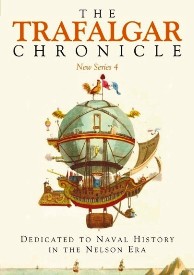 
The Trafalgar Chronicle New
Series 4
edited by Peter Hore
Seaforth, 2019, ISBN 978-1-5267-5950-4, UK £20.00 / US
$39.95
Also available in other formats
    
The annual journal of
The 1805 Club shares the latest
research into Vice Admiral
Horatio Lord Viscount Nelson and
his era. Each issue has a
central theme, and this, the
twenty-ninth such offering,
focuses on his friends and
contemporaries. The majority of
those depicted in this volume
come from families that remain
loyal to the British Crown,
during and after the American
Revolution, even though their
members live in the American
colonies at the outbreak of
hostilities. Others opt to
follow the road toward
independence. These twenty-one
essays also cover a breadth of
distance, extending from
Honduran islands to Australian
shores and several places in
between.
John Lehman’s “The Decaturs, the
Lehmans and the Privateers”
examines the American privateers
during the Revolutionary War
with particular emphasis on
Captain Stephen Decatur, Senior
of the Fair American,
and his ship’s surgeon, George
Lehman.
“The Summer Before Trafalgar” is
Susan K. Smith’s survey of
Benjamin Silliman, a college
professor from America, who
visits England in 1805. He keeps
a journal of his travels and
special events, such as his
opportunity to see Admiral
Nelson and what happens when
news of his final victory and
death reach London. Tom
S. Iampietro
shares the
story of
“Admiral
George
Augustus
Westphal,” who
lives longer
than any other
officer who
serves with
Nelson at
Trafalgar.
Wounded
himself in the
battle, he is
with the
admiral when
he dies. T.
Jeremy Waters,
on the other
hand, looks at
Westphal’s
brother,
“Admiral
Philip
Westphal,”
whose career
is
overshadowed
by his younger
sibling. Also
present
at Nelson’s
death,
“Lieutenant
Richard
Bulkeley” is
immortalized
in Benjamin’s
West’s
depiction of
the admiral’s
death, as
discussed in
John R.
Satterfield’s
essay. Bukeley
is a
midshipman
aboard Victory,
where he
speaks with
Nelson before
he dies. His
own life is
cut short at
the age of
twenty-five.
With
numerous connections to Irish
officers, some of whom are
mentors and others who are
friends and colleagues, one may
almost claim “Nelson Was an
Irishman,” as Des Grant explains
in his essay.
Since seamen face many perils,
it is no wonder that religion
plays a role in the everyday
lives of the crew. Not all naval
chaplains adhere to the
stereotypical preacher, as The
Reverend Lynda Sebbage discusses
in “Sin Bo’suns in Nelson’s
Ships.” One of her atypical
examples is a chaplain who often
finds himself one step ahead of
the authorities.
While men fight the conflicts,
women also play their parts.
Derek Morris and Kenneth Cozens
look at what women of this era
can and do do in “The Role of
Women in London’s Sailortown in
the Eighteenth Century.”
Harold E. ‘Pete’ Stark discusses
“North America’s Seafaring
Cities” in his essay of ports
and how they evolve in North
America, the Atlantic, and the
Caribbean. Not all serve the
same purpose. Nor are they equal
in importance to the Royal Navy.
But all play a role in Britain’s
maritime economy. Anthony
Cross analyzes the development
of hot air balloons and their
use during times of war in
“Bringing Up Franklin’s Baby.”
Anthony Bruce assesses another
weapon in warfare, the navy’s
use of “The Carronade.”
The
man who holds the record for
longest naval service is
“Admiral of the Fleet Sir Provo
William Parry Wallis.” Jeremy B.
Utt outlines this man’s career
from when Wallis’s name first
appears in a muster book when he
is four years old to his time as
Queen Victoria’s naval
aide-de-camp.
Andrew A. Zellers-Frederick
contributes two offerings in
this volume. The first is about
one of Nelson’s Canadian
friends, “Admiral Sir Manley
Dixon, KCB.” The second
discusses “Rear-Admiral Thomas
Tudor Tucker” of Bermuda, who
survives the wreck of HMS Sceptre,
participates in the navy’s
experiment of adding citrus to
grog rations, and is present
when the Royal Navy captures USS
Essex, during the War of
1812. Anna
Kiefer reviews the career of
“Captain William Gordon
Rutherford, CB” of North
Carolina, who enlists in the
Royal Navy more than once and
also serves with the Honourable
East India Company. Barry Jolly
reconsiders the career and life
of “Rear-Admiral John Peyton”
since he has often been confused
with other family members.
“Loyalist
Mariners
during the
American
Revolution” is
Thomas B.
Allen’s
offering. He
covers the
often-neglected
Whaleboat War
and includes
the
perspective of
the common
sailors – such
as Jacob
Nagle, one of
the few
sailors who
shares their
experiences –
who fights. Rui
Ribolhos Filipe’s “The Beach of
the English Dead” considers the
actions of Captain Conway
Shipley, the first British
officer to die in action during
the Peninsular War. Rather than
focus on a particular person,
Mark West delves into the
“Russians on the Tagus” and
their connection to Portsmouth
and the naval hospital at
Haslar.
The final two essays return to
the Caribbean. Rear-Admiral
Michael Harris investigates the
“Battle of St. George’s Cay, 10
September 1798,” which also has
ties to British seafarers and
buccaneers. Douglas Hamilton
probes the extraordinary career
of “Captain John Perkins,” a
black officer and former slave
assigned to protect British
colonies involved in slavery.
In addition to these articles,
black-&-white illustrations,
tables, and maps are found
throughout the book. There is
also a section of color plates
depicting ships, campaigns, and
commentary involving the Royal
Navy. While notes are included,
no index is provided.
This latest offering of The
Trafalgar Chronicles
educates, clarifies, and
demystifies the Nelson Era. Its
focus is broader than some
previous issues, but this serves
to immerse readers in a wider
swath of topics that might
otherwise be missed. The fourth
volume in the new series is a
compelling review of the variety
and depth of research being
conducted, and readers will meet
people and visit places that are
more often than not forgotten in
history books.
Review Copyright ©2020 Cindy
Vallar

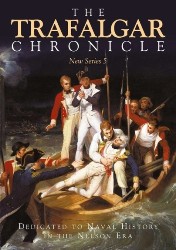
The Trafalgar
Chronicle New Series 5
edited by Judith E. Pearson, Sean
Heuvel, and John Rodgaard
Seaforth, 2020, ISBN
978-1-5267-5962-7, US $39.95 / UK
£20.00
    
Do
visual portrayals of Horatio
Nelson do him justice? Are they
realistic, or do they stem from
their creators’ imagination and
interpretation of him? How
authentic is literature’s
depiction of the Georgian navy
and the men and women who serve
in one capacity or another?
These are themes explored in the
latest yearbook of The 1805
Club.
Using his medical
expertise, Gerald Stule opens
with “Representations of
Horatio Nelson in the Visual
Arts: Heroic Portraiture
Versus Historical Reality from
a Medical Perspective.” He
examines the visual depictions
of Nelson, his ailments, and
his battle injuries in various
mediums to show whether the
portrayals are correct, how
they may have affected Nelson,
and how they shaped his image
as a flawed, courageous hero
who deserves his countrymen’s
veneration.
Andrew Venn
utilizes eyewitness accounts
of Nelson’s tragic demise and
compares them to two paintings
of the admiral’s final moments
in “William Beatty, Arthur
Devis and the Death of Lord
Nelson in Early
Nineteenth-Century Literature
and Art.” This allows Venn to
demonstrate how this event
impacts the legend surrounding
Nelson’s death and how we
perceive these events today.
“Nelson has more
faces than a clock factory,
but nobody today can be
certain about what he really
looked like.” (45) He has long
been a favorite subject to
portray, whether these
depictions be fulsome or
disparaging. This is the
subject of cartoonist Pete
Turner’s “Nelson in Caricature
and Cartoon.”
In 1748, an
author and former sailor pens
a novel that becomes a big
success. Its contents and his
descriptions of the Georgian
navy influence many subsequent
writers of the 18th century,
even if those depictions
aren’t as authentic as
historical accounts show.
Anthony Bruce discusses The
Adventures of Roderick
Random in “Tobias
Smollet and the Early Georgian
Navy.”
In spite of the
fact that women play
significant roles in the lives
of Georgian navy men,
historical novelists often
portray them as peripheral
entities. As Linda Collison
points out in “Beyond Lady
Barbara: Women as Portrayed in
British Naval Fiction,” this
often misleads readers into
thinking that women play less
than significant roles both at
home and at sea.
It is during the
Georgian era that the fouled
anchor is introduced on the
uniforms naval officers wear.
Its popularity as a decorative
item blossoms thereafter. Lily
Style, an expert on Emma
Hamilton and a direct
descendant of her union with
Horatio Nelson, explores the
use of this symbol in “The
Rise of the Fouled Anchor: The
Visual Codification of the
Royal Navy During the 1700s.”
France is often
depicted as the ally who comes
to the aid of the American
colonists in their bid to gain
their freedom from Great
Britain, but Chipp Reid
reveals that Spain also plays
a significant role in the
revolution. He also explains
why few people are aware of
this connection in “Spain and
American Independence: The
Best-Kept Secret of the
Georgian Age.”
In addition to
these thematic essays, the new
editors of The Trafalgar
Chronicle have chosen to
include biographical portraits
and three historic papers
pertaining to the navy during
the Georgian era. These
include:
- “Sir Andrew
Pellet Green: Vice Admiral
Thomas Fremantle’s
Protégé” by Charles
Fremantle
- “Commander
Sir James Pearl” by Sean
Heuvel
- “Captain John
Houlton Marshall” by John
Rodgaard and Lisa Heuvel
- “Captain
Ralph Willett Miller” by
Gerald Holland
- “The Popham
Code Controversy” by Chris
Coehlo
- “Cornwallis,
a Woman Named Cuba, and
the Caribbean” by Barry
Jolly
- “A Second
Naval War: The Immediate
Effects of the American
War on Royal Navy
Operations, June 1812-July
1812” by Samantha Cavell
When
combined with
black-&-white
illustrations, a few graphs
and tables, and a center
section of color plates, these
essays are entertaining and,
at times, fascinating. All the
contributors are eminently
qualified and, as always, The
Trafalgar Chronicle
provides informative glimpses
into new research that leaves
indelible impressions on
readers.
Review Copyright ©2021
Cindy Vallar

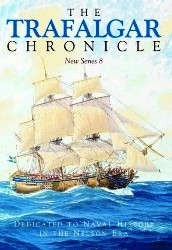
The Trafalgar Chronicle New
Series 8
edited by Judith E. Pearson and John A. R.
Odgaard
Seaforth, 2023, e-book ISBN
978-1-3990-3901-7, US $19.99 / UK £8.99
Also available in other formats
    
The 1805 Club
annually publishes The Trafalgar Chronicle,
a collection of articles about the age of sail
between 1714 and 1835. Each issue focuses on a
particular subject; this time around the “The
Navies of the Georgian Era – An International
Perspective” is the theme. Thirteen contributors
from six countries showcase different navies
prominent during this time period. What they
share allows readers to see how fighting at sea
is only one aspect of gaining the upper hand in
each nation’s desire for naval superiority.
Anthony Bruce writes about “The Battles of Cape
Finisterre, 1747.” The Western Squadron has a
three-pronged mission during its cruises:
protect commercial ships, defend against
invasion, and keep watch over the French. In
this particular year, the Royal Navy engages the
enemy twice at Cape Finisterre. Vice Admiral
George Anson is in command during the first
encounter while Rear Admiral Edward Hawke, the
second.
Nicholas James Kaizer examines sea engagements
involving individual vessels, particularly
sloops, in “Hornet versus Peacock:
The Lost Historical Significance of the
Single-Ship Actions of the War of 1812.” These
engagements may have lacked critical impact
during the conflict, but the losses point out
key weaknesses in competency and command. Change
becomes inevitable because of these defeats and
the resultant inquiries.
The East India Company can’t fully control the
regions in which its ships sail. To compensate
for this, a fleet of ghurabs and galivats is
formed to assist the Royal Navy in protecting
English commerce in the Indian Ocean. Saikat
Mondal explores the “Bombay Marine, the Vanguard
and Precursor of the Royal Indian Navy.” He also
talks about Kanhoji Angre, a man of great
importance in the Indian Navy’s history but whom
the English see as a pirate. Also discussed is
the Bombay Marine’s fight against piracy during
the 19th century.
When Peter the Great decides to bring Russia
into the 18th century, one of his reforms
results in the formation of the Russian Navy. As
time passes, the fleet deteriorates. Catherine
the Great provides the necessities to make the
Russian navy a force to be reckoned with.
Kenneth Flemming examines this history and the
roles Russia’s Navy plays during various
conflicts of the period in “Russian Naval Power
during the Eighteenth Century.”
Although Vice Admiral James Saumarez fights when
necessary, armed engagements aren’t necessarily
the best way to handle volatile situations.
Andrew Venn demonstrates this in “Diplomacy,
Restraint and Protection: The Actions of
Saumarez’s Baltic Fleet 1808-1812.”
While the above essays pertain specifically to
the book’s theme, the second set of chapters are
from The Baltic Cauldron: Two Navies and the
Fight for Freedom. This book was published
in celebration of the Royal Swedish Navy’s 500th
anniversary. Peter Hore, a previous editor of The
Trafalgar Chronicle and a retired officer
of the British Royal Navy (RN), talks about “The
Baltic Fleet 1715-1727 and Sir John Norris” and
“Swedes at Trafalgar.” Christopher Hägg, a
retired officer of the Royal Swedish Navy (RSN)
and marine artist who did the cover art for this
annual, discusses “Vice Admiral Lord Nelson
Threatens the Swedish Fleet in Karlskrona 1801.”
These chapters not only look at the history of
the RSN but also its interactions with the RN in
different capacities. Among topics covered are
the Battle of Copenhagen, Swedes who serve on RN
ships during the Battle of Trafalgar, and the
privateers commissioned by Swedish monarchs.
The third section concerns biographical
portraits. Andrew Field writes about Captain
Charles Cunningham and how he extricates his
ship and his men from the Nore Mutiny in “‘An
Officer of Great Merit’.” Hilary L. Rubenstein
examines two admirals who serve during the reign
of George III in “Rodney and Kempenfelt: How
They Were Related.” Judith Pearson, one of the
book’s editors, shares a discovery of remains
found during the renovation of a church in
Bermuda and her search to learn more in “A Dead
Captain and a Sunken Ship: The Fates of Sir
Jacob Wheate and HMS Cerberus in
Bermuda.”
The last section of this annual concerns
articles of general interest to readers. First
up is Mark Barton’s “Duke of Clarence Swords,”
the presentation swords awarded to RN officers
and how the duke (and future King William IV)
decides who is worthy of such honors. George R.
Bandurek traces what happens to the first
British vessel captured during the War of 1812
in “HM Schooner Whiting After Her
Capture in 1812: The Cartagena Privateer San
Francisco de Paula.”
One quote often associated with Horatio Nelson
is ““The conduct of all privateers is, as far as
I have seen, so near Piracy, that I only wonder
any civilized nation can allow them.” Ryan C.
Walker analyzes what Nelson truly thought of
pirates and privateers and where the quote
originates in the last essay of the collection,
“‘I only wonder any civilised nation can allow
them’: Nelson’s Actual Opinion of Privateers.”
In addition to the notes that accompany the
various articles, the reprinted chapters from The
Baltic Cauldron include titles of books
for further reading. There are illustrations,
both black & white and color, found
throughout the book, as well as a section of
color plates. These include portraits,
paintings, maps, and informational charts.
I usually prefer to read the print book of this
annual, but review copies are only available in
electronic format this time. For readers
unfamiliar with reading the e-book format, I do
caution where you press to turn pages. There are
links to the endnotes and if your finger lands
on one of these numbers, the book automatically
pages to the specific endnote. This can be
disconcerting initially, but there is usually a
way to easily return to where you left off
reading. The e-book is remarkably well done in
layout, formatting, and editing. The only
exception to the editing came when I noticed
that words beginning with “d,” such as "Danes"
or "Dr" (abbreviation for doctor in front of a
name), were uniformly not capitalized.
Always informative, this edition of The
Trafalgar Chronicle will be of interest to
readers who enjoy naval history as well as
piratical or privateering history. All are
captivating reads, while a few particularly held
my attention. Many English histories present
Kanhoji Angre in the negative light of piracy.
Saikat Mondal skillfully shows the flipside of
that coin, that Angre is a great Indian admiral.
The inclusion of how the Bombay Marine helps
suppress piracy in later years is equally
compelling. Having read several fictional
portrayals of the Nore Mutiny, I am wonderfully
surprised to learn about how one captain keeps
his crew and ship safe despite the overwhelming
odds for his men to join the mutineers. Walker’s
analysis of Nelson’s quote is also very
revealing and makes an interesting case for not
taking things at face value. The Trafalgar
Chronicle New Series 8 is highly
recommended, entertaining, and enlightening.
Review Copyright ©2024
Cindy Vallar

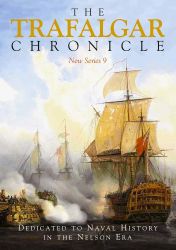 The Trafalgar
Chronicle: New Series 9
The Trafalgar
Chronicle: New Series 9
edited by Judith E. Pearson and John A.
Rodgaard
Seaforth, 2024, ISBN 978-1-3990-7808-5, US
$39.95 / UK £20
Also available in other formats
    
Gathering information on the
enemy is nothing new, but during the
Georgian Era, a formal system to collect,
evaluate, and disseminate acquired data
doesn’t exist. So how do the Admiralty and
its naval commanders acquire what they
need to successfully complete their
missions? This is the theme of this year’s
1805 Club’s annual journal. Steven E.
Maffeo opens with “Secret Intelligence in
the Age of Nelson,” an excerpt from his
book (Most
Secret and Confidential: Intelligence
in the Age of Nelson), which
provides an overview of naval intelligence
between 1754 and 1815.
Officers who wish to succeed and advance
through the ranks understand how important
it is to be seen as gentlemen. Some are
born to this; others must acquire the
culture and sophistication in ways that do
not exceed their financial means. Evan
Wilson shows how such young officers
devise their own grand tours of the
continent by combining work with pleasure
during times of peace in “A Grand Tour on
a Budget: Naval Officers and Intelligence
Gathering in the Age of Sail.” In the
process, they also acquire information
that may be of potential use in times of
wars.
Intelligence and what can be inferred from
it influences how commanders react, as
Andrew Venn Nelson demonstrates in “Cat
and Mouse, Misinformation, Thwarted Plans
and the Victory that Never Was: Nelson and
Villeneuve’s Atlantic Chase, 1805.” Other
times, intelligence plays a role in the
planning and carrying out of specific
operations as Anthony Bruce shows in “‘A
Great and Signal Service’: Admiral Vernon
at Porto Bello, November 1739.” On the
other hand, intelligence can mislead and
have unexpected outcomes as we discover in
Nicholas James Kaizer’s “The Unwanted
Coup: James Callander, Spiridon Foresti,
and British Espionage in the Ionian
Islands during the War of the Second
Coalition.”
The final two entries that address this
annual’s theme are more biographical and
demonstrative in nature. Tom Fremantle
introduces us to “Admiral Arthur Phillip,
1738-1814: Naval Officer, Explorer, Spy,
Mercenary, Administrator.” Natacha
Abriat’s featured monograph investigates
“The Fortunes and Misfortunes of Baron
d’Imbert, 1763-1844: French Naval Officer
and Royalist Agent,” which provides a
unique perspective on French espionage and
counterespionage.
In addition to this year’s main topic, the
editors include three biographic portraits
and five articles of general interest that
pertain to the Georgian Era. David
Rothwell shows how Sir John Thomas
Duckworth considers his orders, his men’s
health, and gaining honor and wealth in
“The Evolution of British Naval Leadership
and Decision-Making in the Face of
Sickness.”
American Joshua Penny is pressed into the
Royal Navy several times during his
lifetime. William S. Dudley discusses this
merchant sailor and why he spends eighteen
months in a South African cave in “The
Seafaring Saga of Joshua Penny,
1788-1815.”
In the last biographical entry,
“Trafalgar’s Last Survivors,” Hilary L.
Rubenstein investigates who can and cannot
lay claim to having fought and survived
the Battle of Trafalgar.
The remaining articles showcase
Parliament’s reaction to the loss of
single ships to the young United States
Navy; the demise of USS Essex in
Valpariso, Chile; the aftereffects of the
Earl of Sandwich’s decision to sheath
warships’ hulls with copper; the
significance of the name of Admiral
Villeneuve’s flagship at the Battle of
Trafalgar; and a Spanish princess who
believes she is the rightful ruler of
Spain’s American possessions while her
father is imprisoned and her husband rules
Portugal from afar.
- The
War of 1812 in Parliament: Britain’s
Naval Ops and the Political Discourse,
1812-15 by Kevin D. McCranie
- Facts
and Firsts for The United States Navy:
Remembering the Cruise of the USS Essex,
1812-1814 by Branden L Bliss
- The
Cost of Wartime Innovation: Copper
Bottoms and British Naval Operations
during the American Revolutionary
Wars, 1779-83 by Samantha A. Cavell
- The
Historical Significance Behind the
Name of Villeneuve’s Bucentaure by
John Law
- Who
Will Rule? The Struggle for Power in
Río de la Plata, 1808-10 by Ricardo
Caetano de Moraes
Black-&-white
illustrations are found throughout the
essays with a center section of color
plates, all of which complement and enrich
the text. Biographies of the contributors
and endnotes are included, but there is no
index.
As always, reading The
Trafalgar Chronicle is a treat. The
articles provide a wealth of information
that enlightens and enhances our
understanding of this period in naval
history. This is one of the few places
where you will find a collection of
offerings dealing with naval intelligence.
Even if you think you know a particular
subject, you discover tidbits you aren’t
aware of. Some articles will confirm what
you already know; others will have you
rethinking assumptions and seeing topics
in new lights. All of which makes this
edition a robust treasure indeed.
Review Copyright ©2025
Cindy Vallar


Click to contact me
Background image compliments
of Anke's Graphics |







